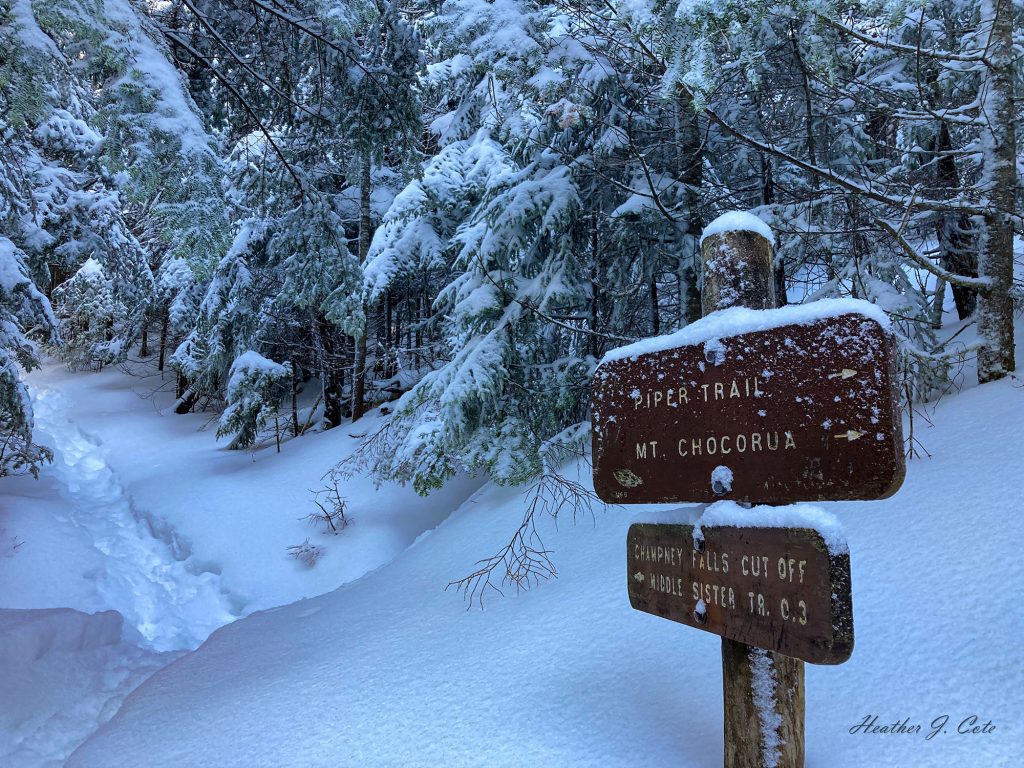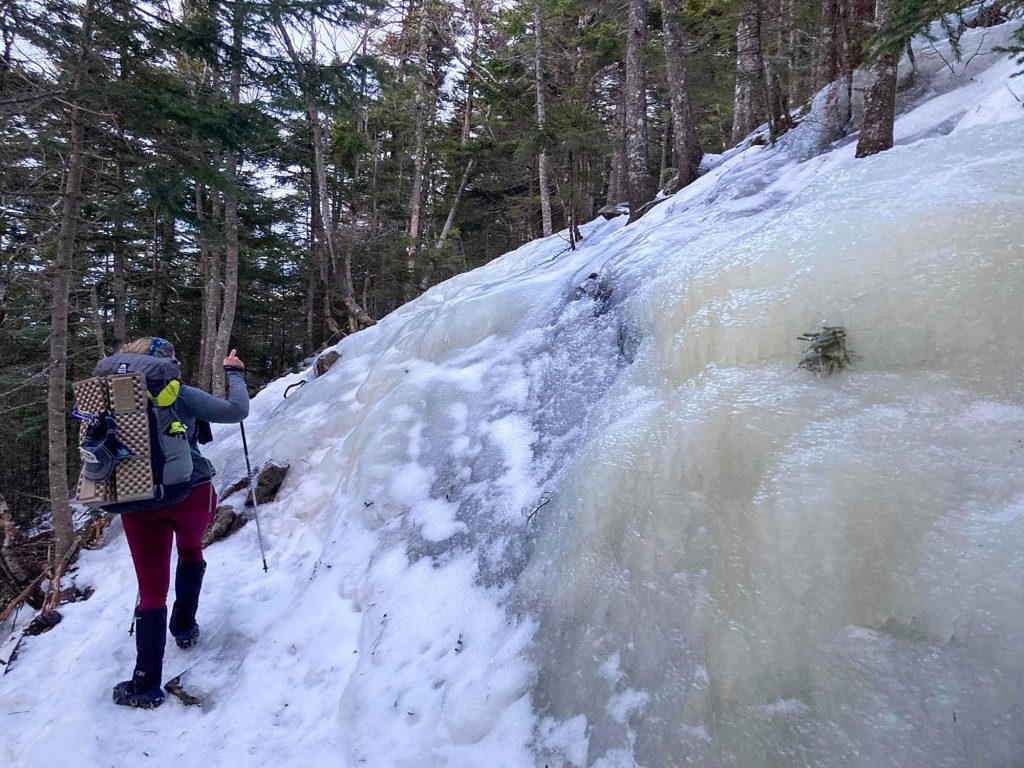If you hike long enough, especially in poor or winter conditions, turning around without completing your objectives will become a regular occurrence. The sign of a good hiker is the ability to recognize when it’s time to turn around and keeping yourself safe doing it.
Before we address those signs and signals every hiker should be aware of, let’s first talk about why people do not turn around and the trouble that can result. Circumstances include poor route planning, lack of information about the weather forecast (or ignoring what it says), improper equipment, lack of physical conditioning, and time constraints, to name a few. To be frank, we will never be able to quantify the number of search of rescues that didn’t take place, but close calls happen all the time. You may read this and be able to draw up an instance when you had a close call or pushed your day too far. With 10 years of hiking under my belt, I can recall instances when I both pushed through and turned around. Over time, I developed a comfort level and a threshold I was willing to reach which has guided my adventures in the mountains. But knowing the signs is the first step toward managing your risk.

Route Planning
A three-season hiker in the Northeast should be aware of the changes that occur to trails once the weather starts dishing out ice and snow. Those beautiful and exciting dry slabs in July can be a dangerous slip and slide come December. The tame brook you rock hopped over in September can become a rushing river or lightly frozen tundra, unsafe for passage. The White Mountain National Forest Roads close for the season, which adds miles to the start and end of a normally reasonable length hike. Use reliable trail guides, such as the Appalachian Mountain Club’s White Mountain Guide, to educate yourself on the trails you intend to hike. Check trail conditions the day of your intended hike day by using sites such as New England Trail Conditions and Trails NH. Utilizing sites such as these will give all levels of hikers a preview of trail conditions and equipment used by others for safe passage. Do your part and post up a review to these sites in the winter to let others know what to expect.
Even the best-laid plans can have pitfalls. If your route isn’t packed out and you aren’t physically fit to break it out in snowshoes, turning around and waiting for another day may be the best option. Hit a water crossing that was reported to be passable but clearly isn’t? Enjoy the return walk to your car if a safe bushwack option isn’t available.
Weather
If you do anything to prepare for your hike, check the weather. I don’t mean the local weather station forecast, but rather the higher summits forecast. One of the most valuable sources for mountain weather is the Mount Washington Weather Forecast from the Observatory. I use this as a “worst-case scenario” for peaks in the Whites and plan accordingly. You can get up-to-date forecasts and weather information from the Observatory by texting “weather forecast” to 603-356-2137. This service was implemented within the last year and is a great tool! I also frequently check the National Weather Service Recreation Report for New Hampshire and Western Maine. This forecast breaks conditions down by elevation. Check these sources year-round as part of planning a smart hike.
Perhaps you checked the forecast and the weather turns…now what? I often say the mountains have a mind of their own. Case in point, I drove through North Conway on an 80-degree June day only to find Crawford Notch socked in. I hiked up to Mount Pierce with a friend, putting on all of the layers in our packs as we climbed. We found 30-degree temperatures and wind-whipped rain on the summit. These conditions were not indicated in the summit reports I checked before departing in the morning. Be prepared for all conditions and have a plan to bail if needed. No summit is worth hypothermia or other cold-related injury. You make that social media post another day.

Equipment and Supplies
Despite packing adequate gear, such as Ice Talons and snow shoes in the winter, you may find yourself facing trail conditions that are impassable. Remember that icy slab? There are just some times your traction won’t bite. Take pause and turn around if you can’t safely make the pass. If you are hiking an out and back, consider whether you will be able to come back down this section of trail without risk of injury. Some days, it’s simply not worth it.
Changing conditions may test the layers you have brought along and you may find your cold threshold quicker than expected. If you are chilled (this goes for summer hikes too) consider if you have the ability to warm up. If the answer is no, turning around and trying again another day may be the best option.
Take stock of your available nutrition as your hike progresses. If you start to run low on water (without the ability to purify more) and food, this should start signaling a plan to turn around. Dehydration and lack of nutrition can lead to deadly consequences.
Time
Time matters. During the summer months, an average hiker may never need to pull their headlamp out of their pack. In the winter, many hikers will tell you they will start or end a hike using their headlamp. Consider your level of comfort hiking in low-light conditions while planning your route. Consider your “hard turnaround” time in advance. This is imperative for making it back to the trail head in all conditions. Fitness level, weather and trail conditions impact time. Biting off more than you can chew can be a recipe for disaster. A hard turnaround time will often ensure a safe conclusion to your hike, despite not bagging the intended summit that day.
Out-and-Back vs. Loop Hikes
I placed this in its own category because it’s important in considering turning around or bailing out. The options change on loop hikes or point-to-point hikes due to the “point of no return,” when turning around is just as long of a return trip as continuing forward. Only you, in that moment, can make the right choice. Consider if the trail ahead is packed out. If not, turning around may be the faster option back to the car. If you do not know the trail ahead, turning back is almost always the best option. If you are alone, returning on the path you started on is the safest bet. Take the path (and conditions) you know back to the car.

About Bailouts
I spoke with Maura LaChappelle of “Northern NH Rides: Hikers, Cyclist, Kayaks, Airport and More.” She has been driving hikers for a number of years. She reports the number of calls she received for bailouts in 2022 was higher than in previous years. Poor route planning continues to be a common reason for bailouts. LaChappelle contributes this to inexperience in the Whites. A one-day Presidential traverse is not for the faint of heart and should be tackled with a baseline of fitness. This is a commonly bailed-on route for inexperienced hikers. Maura has in-depth conversations with those she drives, asking if they have the gear they need (including their car keys and cell phones!), know the weather forecast, and have their navigation tool of choice. LaChappelle keeps basic supplies on hand for purchase, such as headlamps and maps, in hopes of preventing a search and rescue incident. While she is available for bailouts when not already booked, she takes pride in helping hikers plan ahead for their day to prevent a bailout ride.
In closing, remember the mountain will always be there. No summit it worth placing yourself or others in harm’s way. Playing on the trails long enough eventually leads to a hard day when you aren’t physically up to the challenge or problem that pops up along the way. Take the day for what it is, regroup, and come back with a new plan!
Heather Cote
Heather is a lifelong outdoors woman, exploring trails as a child and young adult on horseback. She transitioned to hiking, backpacking, and ultra running in the last 8 years and is eager to continue exploring. Her “playground” is the White Mountains of New Hampshire and trails throughout New England. When not exploring, she enjoys photography, writing, and spending time with her people and animals.
Related Posts
April 2, 2024
10 Tips for Mountain Biking Etiquette During Mud Season
One rough spring could ruin the…




